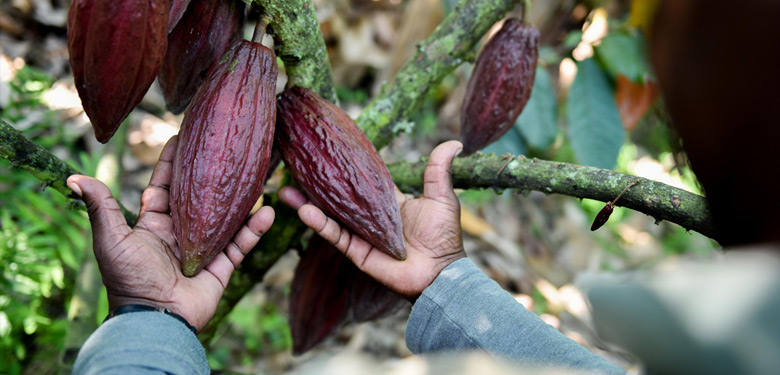
Climate change and chocolate
Chocolate is made from cacao beans that grow on cacao trees. Cacao trees only thrive in rainforest conditions with fairly uniform temperatures, high humidity, abundant rain, nitrogen-rich soil, and protection from wind. Cacao is primarily produced in countries along the ‘cacao belt,’ a thin band roughly 20 degrees latitude north and south of the Equator, namely in Côte d’Ivoire, Ghana and Indonesia, as well as countries in Africa, Asia and the Americas.
Approximately 70% of the world’s cacao (Theobroma cacao) originates from the West African cacao belt which stretches from Sierra Leone to southern Cameroon. Over half of the world’s chocolate is produced in just two countries – Côte d’Ivoire (20% of GDP) and Ghana (9% of GDP) – primarily run by about two million small independent family farms. The sector’s long-term prosperity and sustainability is threatened by declining yields resulted from poor tree and soil management, cacao tree pests and disease, an aging tree stock, underinvestment in maintenance, and a lack of training and support throughout the supply chain.
Climate change can exacerbate some of these issues – West Africa is already susceptible to drought and smallholders are already suffering from reduced yields and quality due to changing conditions that include more variable rainfall, increasing temperatures, and changing patterns of pests and diseases. Climate change can lead to long-term reduction in land with suitable climatic conditions for future cacao cultivation (Figure 1).

Figure 1. Relative climatic suitability (in percent) for cocoa of the West Africa cocoa belt under current and projected 2050s climate conditions, as well as suitability change based on 24 climate variables. The red lines show areas of cocoa production.
While seasonal drought stress is one of the biggest issues for cacao farming, maximum temperatures during the dry season may become as or more important than water availability. By 2050, maximum temperatures during the dry season are project to increase substantially for large parts of the cacao belt, and in Guinea, Sierra Leone, Liberia, and parts of Togo and Nigeria could experience maximum dry season temperatures currently only found in the African savanna, and are approaching the upper tolerance limits of cacao trees1. Increasing temperatures may also push the optimal altitude for cacao cultivation into higher mountainous terrains.
A shift in the cacao growing regions could have repercussions for global cacao output, along with the national economies and farmer livelihoods that depend on the yield. The concentration and implied vulnerability of cacao cultivation in this region could affect the global industry as the regional climatic suitability declines.
Climate-Smart Practices
The projected climatic impacts on the cacao belt will vary within and among West African countries. Hence, the practices necessary to improve resilience will depend on local circumstances and potential climate threats. At the crop level, climate resilience measures include the selection of cacao varieties and shade trees that are tolerant to heat, drought, and diseases.
At the farm level, the maintenance or increase of shade trees in cacao farms could protect cacao trees from wind and erosion, reduce heat stress and evapotranspiration, and provide nutrient-rich leaf litter. This may be particularly beneficial in the hotter and drier northern parts of the cacao belt, and also during exceptionally hot years along the coastal areas. In addition, the diversification of farming systems with crops and trees that have varying environmental needs, as well as farmers’ income streams could offer some buffer against market volatility and environmental risks.
In the coming decades, cacao production may shift towards areas where the local climate remains favorable to cacao farming. This could however cause a wave of deforestation in Liberia, Cameroon and possibly the Congo basin. At the national and regional policy level, it is therefore important to encourage the intensification of existing cacao farms with suitable climatic conditions and the intensification of existing cacao farms and channel new cacao expansion on already deforested land through effective agricultural and forest conservation policies.
The World Cocoa Foundation (WCF) supports both sustainable livelihoods and a reliable cocoa supply by working with its members in the cocoa and chocolate industry to help cocoa farmers adapt to climate change and fight deforestation – which contributes to climate change.
For instance, in 2016, WCF launched the Feed the Future Partnership for Climate Smart Cocoa with support from United States Agency for International Development (USAID) and nine WCF member companies in West Africa (Côte d’Ivoire, Ghana, and Liberia) and Latin America (Dominican Republic, El Salvador, Honduras and Nicaragua). The program involves governments, civil society organisations and industrial experts, and aims to enhance private sector investment and engagement in climate smart cocoa, with a focus on strengthening farmers’ climate resilience through the development of collaborative national and regional climate smart cocoa strategies. In addition, WCF also works with technical experts to improve climate impact models in West Africa and Central America.
Some companies such as Mars, Incorporated have considered the potential impacts of climate change on their global supply chains, and recognize that sustainable sourcing can not only help reduce greenhouse gas emissions, but also build resilience against climatic challenges. As part of their sustainable sourcing strategies, Mars have set up water efficiency programs with farmers in water-stressed regions along their rice supply chain in Pakistan, India and Spain. Initial results from Pakistan indicate a 30 percent reduction in water use and a 75 percent increase in farmers’ income.
1. Schroth G., P. Läderach, A.I. Martinez-Valle, C. Bunn, L. Jassogne (2016) Vulnerability to climate change of cocoa in West Africa: patterns and opportunities and limits to adaptation, Science of the Total Environment, 556, 231–241.